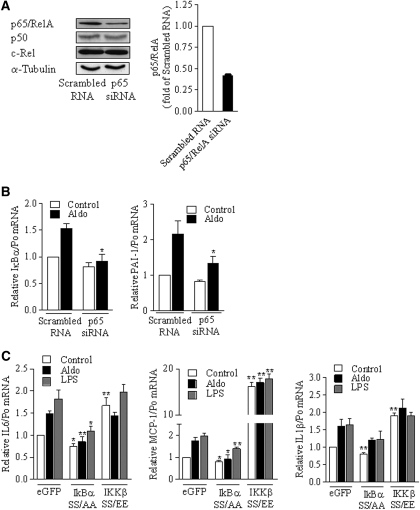Figure 4.
The effect of aldosterone relies on the activation of the canonical NF-κB pathway. (A to B) mCCDcl1 cells were transfected with either siRNA targeting p65/RelA or scrambled RNA, seeded on plastic support (A) or permeable filters (B), and incubated in the absence or presence of 10−6 M aldosterone for 6 h, before protein (A) or RNA (B) extraction. (A) Specific p65/RelA knockdown by siRNA. p65/RelA, p50, c-Rel, and Na,K-ATPase α-subunit, taken as a loading control, were detected by immunoblot. Representative blots from three independent experiments are shown. Bars show the densitometric quantification of p65/RelA immunoreactivity expressed as fold of OD measured in scrambled-RNA transfected cells. (B) Silencing of p65/RelA by siRNA blunted the increased expression of NF-κB–targeted genes in response to aldosterone. IκBα and PAI-1 mRNA were detected by RT-PCR. (C) mpkCCDcl4 cells transfected with eGFP, super-repressor IκBα SS/AA, or constitutionally active IKKβ SS/EE mutants were processed as described in B. LPS- or aldosterone-induced expression of MCP-1, IL-6, or IL-1β mRNA were blunted by IκBα SS/AA or IKKβ SS/EE mutants. Results are expressed as fold of value in nonstimulated scrambled RNA or eGFP transfected cells. Bars are means ± SEM from six independent experiments. *P < 0.05 or **P < 0.01 versus scrambled RNA or eGFP.

